Bait hives
The swarming season is almost upon us. Colonies now have good levels of drone brood and increasing numbers of mature drones. The weather is improving. There’s a good flow on from the oil seed rape and colonies are starting to get overcrowded. Inevitably this means that colonies will start making preparations to swarm … recent inspections show increasing numbers of ‘play cups’ and a few charged queen cells.
I usually leave a couple of empty boxes in likely spots to act as bait hives, primarily to catch swarms from my own colonies but – with the concentration of beekeepers in the Kenilworth/Coventry area – possibly to attract a swarm someone else has lost. I try and clip my own queens to prevent losing a swarm … in a semi-urban environment I don’t want to bother my neighbours. However, there are always a couple I’ve missed, perhaps due to late supercedure or simple forgetfulness.
The requirements for a bait hive are beautifully described in Tom Seeley’s book Honeybee Democracy. They can be summarised as a south-facing, National-sized, solid-floored box, small entrance, preferably located high off the ground. To make them more attractive they should contain a frame or two of old manky drawn brood (no stores though as this encourages robbing) and have a dab or two of lemongrass oil added. I’ve previously used spare National brood boxes containing only two old black frames. However, if a swarm takes up residence they can build comb very quickly, so this year I’m experimenting with a full brood box of foundationless frames.
I have a couple of Modern Beekeeping National poly hives. These are high quality but – in my view – poorly designed. The brood box is fractionally too narrow, meaning that frames fit well until they’re propolised after which everything gets too tight to move. The external dimensions are about the same as a cedar National but the walls are thicker meaning they can only take 10 frames. The floor is mesh and the crownboard is a simple sheet of semi-rigid clear plastic. The supers have an overhanging lip which makes re-assembling a hive after an inspection fraught. These are being used as bait hives this year.
I’ve covered the mesh floor with cardboard, added the two old frames (in retrospect only one is really needed) on the outside and filled the space in between them with foundationless frames – a standard brood frame with 15kg fishing line horizontal supports and a 2cm starter strip of foundation. Tom Seeley describes how scout bees measure the volume of a potential new home by a series of walks and short flights. The hope is that the foundationless frames will provide the guides for the new drawn comb, but that most of the ‘space’ will appear empty and so of an attractive size for the swarm. It also saves on the cost of seven sheets of foundation.
I’ve added a few drops of lemongrass oil to the top bars of a couple of frames (take care, it dissolves poly hives) and strapped the entire thing together securely. I’ve placed one on the top of my garden greenhouse, about 8 feet off the ground. The other is about 30 metres from my out apiary, on a normal height stand. I’m not sure I’m convinced about the need for height … the swarms I’ve caught in the last couple of years have all been in bait hives at or below waist level.
Update
It must be the season … a post on bait hives has also been made on the Beekeeping Afloat blog.
Update
Both these bait hives were occupied by swarms in the first week of May.
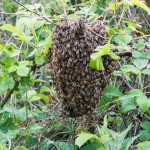
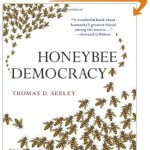
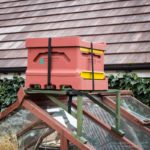
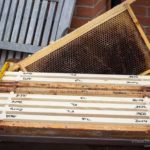
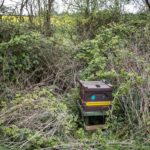
Join the discussion ...